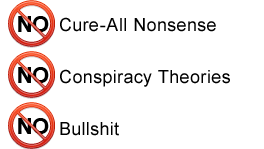From the Desk of The People's Chemist
Hurry! I am now shipping. No longer sold out.
My bestseller, CardioFX, is going fast!
If you ever wondered how to protect your heart, read this article, then learn more at http://www.getcardiofx.com - or skip the article and gop now to guarantee your order...Your choice.
"I've never felt better! I thought at 42 years old I was supposed to feel lethargic and gain weight...Little did I know it was my MEDS! Thanks TPC...I feel so stupid for not knowing this before." - KB, Texas
http://www.getcardiofx.com
Why High Cholesterol Will Never Cause Heart Disease
"Lower your cholesterol and prevent heart disease (atherosclerosis)!"
Medical Doctors, drug manufacturers and nutritional supplement companies make billions of dollars browbeating us into believing this statement. Despite the exuberance with which it is made, this standard health myth can be debunked faster than your doctor prescribes Lipitor.
Since this myth persists among some of the most respected health experts, it will be hotly debated and threatens the reputations of leading health practitioners and pharmaceutical companies worldwide.
Heart disease, the leading cause of death for all Americans aged 35 and older, is clinically defined as the narrowing or hardening of the arteries which transport blood away from the heart to various organs in the body. This transportation ensures that oxygen and nutrients are delivered to all areas of the body, and the process by which arteries become narrow or hardened due to plaque is referred to as atherosclerosis. Atherosclerosis greatly inhibits circulation, and heart attack or stroke is the end result.
Looking at trends among those with atherosclerosis and setting the following criteria, we can easily test the validity of the claim that “high cholesterol is a major risk factor for heart disease.” This criterion is a simple matter of action and reaction.
The myth is only true if there is a correlation between total cholesterol levels and changes in atherosclerosis (plaque) development. In other words, as cholesterol increases so should plaque within the arterial walls. Or as cholesterol decreases, so should plaque.
Searching for a correlation between cholesterol levels and atherosclerosis is as simple as looking at the arteries of dead people. This search began in the early 1960s.
In 1961, researchers Mathur and colleagues studied the levels of cholesterol and the degree of atherosclerosis seen at autopsy within the arteries of 20 deceased patients as well as 200 more cases selected from medical libraries. All cholesterol levels were taken within 16 hours of death. No correlation could be observed between these patients’ blood cholesterol levels and the amount or severity of “atherosclerotic plaque” within the arteries. Cholesterol levels, whether high or low, had no impact on the growth of atherosclerotic plaque – the major cause of heart disease.
In 1962, the American Heart Journal published the research of Dr. Marek and colleagues who also searched for a correlation between cholesterol levels and atherosclerosis. Among 106 cases studied, the level of cholesterol did not affect atherosclerotic changes in plaque.
Dr. Marek concluded by asserting that his results do not differ from the results obtained under the exact same examinations in health and disease with atherosclerosis, conducted by the same methods, in the same laboratory, and in the same populations.
The American Journal of Clinical Nutrition shows that at autopsy, postmortem patients who died suddenly showed no correlation between total cholesterol levels and atherosclerosis. Researchers Jose Mendez, Ph.D., and co-workers point out that their findings agree with previous studies. Notably, they cited researchers Lande and Sperry, who as early as 1936 also failed to find a correlation between cholesterol levels and atherosclerotic plaque.
These studies shake the foundation of the current medical model for treating or preventing heart disease. Although logical, highly educated folk totally miss them.
Continuing the search for a correlation between cholesterol levels and atherosclerotic plaque, we can use state of the art technology. Rather than looking at arteries before and after death we can simply look at them while the patient is alive. Utilizing a special X-ray imaging machine known as electron beam computed tomography (EBCT), scientists are able to look at both cholesterol levels and atherosclerosis buildup in the arteries without waiting for patients to die. Electron beam tomography – representing the next level in cardiac diagnosis – allows medical doctors to non-invasively visualize the coronary arteries.
Utilizing EBCT technology, researchers Hecht and Harman of Beth Israel Medical Center, New York, set out to determine whether or not increased cholesterol levels, specifically LDL-cholesterol, led to plaque build up. Looking at 182 individuals who may develop symptoms of heart disease over 1.2 years of treatments with cholesterol lowering drugs alone or in combination with niacin, it was discovered that despite lower cholesterol levels, there was ZERO difference in the development of atherosclerotic plaque. As these researchers concluded, “with respect to LDL-cholesterol lowering, lower is better’’ is not supported by changes in calcified plaque progression.”
Noted by CNN, medical doctors and drug companies who circulate the cholesterol myth are threatened by EBCT.
Continuing the search for a correlation between cholesterol levels and atherosclerotic plaque, we can look to the earlier cholesterol-lowering drugs known as “fibrates.” These drugs, having the ability to successfully lower cholesterol, should have prevented deaths form heart disease among those with high cholesterol. However, the U.S. Government documented that this was not the case.
In its report to Congress, Cholesterol Treatment – A Review of the Clinical Trials Evidence, the U.S. General Accounting Office (GAO) stated, “With respect to total fatalities ─ that is, deaths from CHD [heart disease] and all other causes ─ most meta-analyses show no significant difference and thus no improvement in overall survival rates in the trials [using fibrates] that included either persons with known CHD or persons without it.”
Recognizing that drug companies and purveyors of the cholesterol myth would not be happy with this conclusion, the GAO concluded, “This finding, that cholesterol treatment has not lowered the number of deaths over-all, has been worrisome to many researchers and is at the core of much of the controversy on cholesterol policy.”
Continuing the search for a correlation between cholesterol levels and atherosclerotic plaque, we look to the “statin drug trials.” If high cholesterol were the cause of heart disease, then the greatest preventive effects from statin drugs would be seen in these trials among those with the highest cholesterol levels and in patients whose cholesterol levels were lowered the most. This has yet to be seen in any study.
Looking at the statin drug trial known as the Heart Protection Study (HPS) and the Scandinavian Simvastatin Survival Study (4s), statin drugs are just as effective whether cholesterol is lowered by a small amount or by more than 40%. For instance, the same benefits from Zocor were seen in patients who had a 40% drop in cholesterol and who had no drop in cholesterol. Scientists, recognizing this, stated, “Surprisingly, people [using Zocor (simvastatin)] in the Study [HPS] with normal or low cholesterol had the same heart benefits as those with high cholesterol.”
To highlight this point, we can look to the latest and greatest statin drug, Crestor. Crestor plummeted cholesterol levels yet failed to show any effectiveness, as could be seen by a 0% decrease in total mortality rates among users.
Other drugs show this same tendency. A drug trial known as REVERSAL showed that although Pravachol lowered LDL-cholesterol by 25% it failed to stop the progression of heart disease, as could be seen by the continued growth of atheroma (thickening and fatty degeneration of the inner coat of the arteries). Lead investigator, Dr. Steven Nissen, dumbfounded, commented:
“Surprisingly, despite attaining a low LDL level on pravastatin [Pravachol], these patients showed highly significant progression for percent atheroma volume and percent obstructive volume….”
He continued:
“When I started this study I believed that any reduction in progression would just be due to lower LDL levels, but now I’m not so sure.”
Hammering the Nail into the Cholesterol Myth
Let’s go ahead and hammer the nail into the cholesterol myth coffin. If it is true that the risk of heart disease rises as blood cholesterol rises, then we should see elevated total cholesterol among those who die early from heart attack. This, too, has not been the case. Specifically, half of all heart attacks and strokes occur in persons without elevated levels of cholesterol.
Let’s cover the coffin with a layer of cement. If cholesterol caused atherosclerosis; then we would find atherosclerosis throughout the estimated 100,000 miles of adult blood vessels (arteries, veins and capillaries) within the body through which cholesterol travels. Yet 90% of the time when atherosclerosis is found in the coronary arteries the rest of the arteries remain unharmed by cholesterol.
To say that cholesterol is the culprit is akin to saying that if you jump in water only your hair will become wet while the rest of your body remains dry. If this sounds absurd to you, so should the cholesterol myth when you consider the scientific evidence.
An estimated 2700 people die every day from heart disease. Considering the amount of money that is made from the cholesterol-lowering myth, the problem isn’t going away. Pharmaceutical companies are making billions from the sales of cholesterol lowering drugs every year. The CEO of Pfizer, makers of the popular cholesterol-lowering drug Lipitor, makes $21 million dollars annually (not including his tens of millions in stock options). This equates to around 1.8 million per month, which is about $87,500 per day.
Those who, after reading the evidence, still adhere to the antiquated medical model of lowering cholesterol to prevent heart disease will most likely suffer from it. Adding to their declining health, they will suffer from the dangers of low cholesterol. Learn how to beat it naturally at http://www.getcardiofx.com
About this Newsletter
Natural Cures Watchdog is published by Shane "The People's Chemist" Ellison. He is an award-winning chemist with a masters degree in organic chemistry and author of Over-The-Counter Natural Cures, winner of the Pinnacle Book Achievement Award. This is a FREE service so that NOBODY IS LEFT BEHIND. Please join him in his efforts to educate the laymen by FORWARDING this email to your friends and loved ones. You can sign up at http://www.thepeopleschemist.com.
|






 |